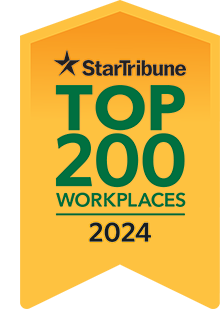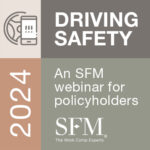 Peter Lindquist has been part of the legal team at SFM since 2018. Prior to that, he practiced for four years in the areas of workers’ compensation defense, general civil litigation, and employment law. We asked Lindquist to share a little bit about his background and role.
Peter Lindquist has been part of the legal team at SFM since 2018. Prior to that, he practiced for four years in the areas of workers’ compensation defense, general civil litigation, and employment law. We asked Lindquist to share a little bit about his background and role.
Tell us a little bit about your background.
I’ve been with SFM’s in-house law firm for just over five years now. I got into workers’ compensation and law because my dad was a defense attorney handling a lot of workers’ compensation and employment law issues.
Ever since I was a kid I worked at his office. I started flipping copies when I was younger. Then when I was in college, I started doing more substantive stuff and that led me to go to law school.
I practiced and worked with my dad for four or five years doing work comp and employment law. Then I decided it was time to spread my wings and found my way to another firm and then to SFM.
How would you describe your role in a nutshell?
I kind of have two jobs. One of them is to represent SFM and its insureds in litigated workers’ compensation claims. That’s my primary role.
But I’m also a resource and adviser to SFM’s claims adjusters, medical-only reps and policy holders when they have non-litigated claims. That’s something that SFM does really uniquely compared to when I was in private practice and what I’ve heard of other companies that have in-house law firms.
Also, there’s a strong integration between our in-house law firm and the Claims team. Claims adjusters can walk down to our office or call us up any time they have questions to talk to us. We’re not just litigating claims.
How is SFM different from other companies you’ve worked with?
That integration piece is a huge part of it.
I found it difficult in private practice to strike a balance between being an advisor and providing good and candid advice to clients; and also being a business person and having to think about how to please clients and get return business. I also hated having non-communicative clients that I didn’t have a direct line to. I don’t see either of those as issues at SFM.
We’re colleagues and we can speak directly and frankly about the claims we’re handling, and people are responsive.
What about your job is particularly rewarding?
I do really enjoy the times we’ve had in meetings with policy holders, especially small business owners who are new to work comp, where we kind of give them the work comp 101. We do a fair amount of that.
We’ve got a lot of big employer entities that know their stuff but getting to work with those smaller entities that don’t know it as well is rewarding.
What do you like about your job?
I like getting to explain things and help people solve problems.
I also like the problem-solving part of the litigation and day-to-day side. Every new claim that comes in is like a puzzle. You get to look at all the pieces – what are the facts, what are the issues, what does the medical report say? Then you start using those to paint a picture about the case. I really enjoy that part of it.
What’s most challenging about your job?
Litigation is stressful and time-consuming, and has constant deadlines to meet. And you have to work hard to keep a cool head in contentious situations, and in dealing with difficult personalities.
What words of wisdom do you have for small-business employers?
Communicate. Remember that with SFM you’ve got so many resources – claims adjusters, med reps, doctors, attorneys. Communicate with us, use us. When you’ve got an active claim, keep us in the loop as to what’s going on. We’re a team and we should work as a team.
Tell us a little bit about yourself.
I live in the northwest suburbs of the Twin Cities. I’m married and my wife and I have an 8-month-old at home, and that’s the biggest thing in our lives right now.
Outside of that than that, I play guitar in a couple of bands. My three younger brothers and my dad are all musicians, too, so that’s a big part of our family gatherings and activities.
View more news about SFM



 Peter Lindquist has been part of the legal team at SFM since 2018.
Peter Lindquist has been part of the legal team at SFM since 2018.